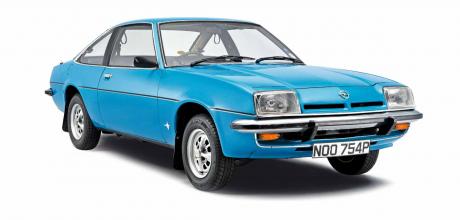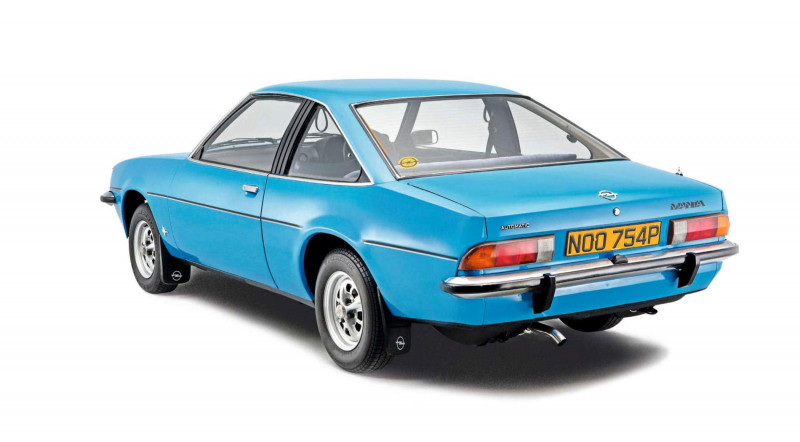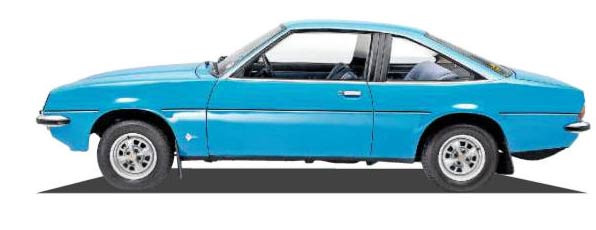Six steps to buying a Opel Manta B

Buying Guide Pick carefully, and a bargain Opel Manta can be yours for as little as £2k. They can be challenging to run, but these drivers’ cars are real bargains – for now. Words Richard Dredge. Photography John Colley.
Six steps to buying a Opel Manta B
Best Manta buys from £4k
If you want a Seventies coupé the chances are you’ll be drawn to a Ford Capri. But there’s a less obvious alternative out there that offers a distinctive driving experience and arguably just as much style – yet you can pick one up for far less money. We’re talking about the rear-wheel drive Opel Manta and Vauxhall Cavalier coupé/ hatch of course, offered in four-cylinder form only – one of the reasons Capri V6-fanciers might discount it straight away.

The Manta makes a great bargain classic. While pre-1982 cars are desirable because they’re rare and feature a relatively pure design, it’s the later B2-generation fuel-injected, Group B rally-inspired GT/E that’s the most sought-after and commonly-found Manta. While major corrosion is a common issue, the Manta is enormous fun, a little bit left-field and more affordable than that Blue Oval alternative – and sadly a lot rarer too, especially in good condition. To steer you towards buying the best, this guide pools the collective expertise of Simon Peckham of Suffolk County Mantas, David Howell of Mantasport, and Tommy Heaney of the Heaney Motor Company.
Which one to choose?
- Based on GM’s Opel Ascona/Vauxhall Cavalier twins, the Manta B was launched in 1975. UK cars were known as Vauxhall Cavalier Sportshatch (three-door) and Coupé (two-door), with a choice of 1.6-/1.9-litre engines. The GT/E, featuring a fuel-injected version of the Manta A’s 1.9, headed the range. The GT/J, a 1.6-litre base model with steel wheels, sat at the bottom.
- An all-new GT/E was launched in 1979, with a 110bhp 2.0 ohc with Bosch L-Jetronic fuel injection. The carburetted 1.9 was replaced by the Manta S, featuring the new 2.0 sporting a Rochester Varajet II carburettor.
- The Vauxhall variants were dropped, and the range overhauled into the retrospectively named Opel Manta B2 in 1982, its appearance inspired by the Irmscher Group B rally Manta i400. The 1.6 was replaced with the 1.8S, with a new ohc 1.8 plus optional Berlinetta luxury trim. The 2.0 S was discontinued in 1984.
- A mass-market Group B lookalike, the 1985 i200, combined an Irmscher bodykit with a GT/E engine tuned to 125bhp; 300 special-edition i240s had 136bhp.
- The Exclusive, a 110bhp GT/E run-out special with an i200 bodykit and twin headlights, sold from 1986-1988.
Bodywork
You’ll be doing well to find a rust-free Manta and panel availability is patchy. Start by looking for corrosion in the chassis rails, which rot and they’re double-skinned so proper repair means removing the front suspension to gain access. Rotten chassis legs are a problem on sunroof cars – the sunroof’s drainhole is meant to channel water into the legs from where it’s then released but the drain holes block up with predictable results. The sunroof surround is another problem because when it rusts it’s a pain to repair properly.
The sills along with their jacking points also dissolve, along with the A-post, wheelarches and door/ tailgate bottoms. Don’t forget to also check underneath the battery tray, behind the headlights and under the washer bottle – all of these areas rust out of sight. The same goes for the metal behind the front valance on later Manta ‘B2s’, while the rear quarter panels on all Mantas and Cavaliers needs careful inspection for corrosion from the inside out.
Other places where the Manta suffers from water ingress are the footwells. The fronts tend to fill with water if the door seals perish, whereas the rears get soaked when the rear side-windows’ hinges lose their grip, and with it the seal of the glass. Peel back the floor carpet and look for evidence of damp and rotting steel. The leading edge of the bonnet rusts after getting chipped; the same goes for the panel that surrounds the headlamps. The mountings for the boot lid hinges of the coupé get bent out of shape over the years, but they can be straightened.
Repairing a rusty Manta bodyshell professionally will cost anywhere from £2000 to sort rusty sills, to at least £6000 to tackle extensive rust, with the price rocketing north of £10,000 if new body panels are required. New-old stock panels will need sourcing from mainland Europe and will cost at least £1000 each even before import duty is applied.
Engine
All UK Mantas got a four-cylinder in-line engine that displaced either 1.6 or 1.9 (a cam-in-head unit) or an overhead-cam unit that displaced 1.8 or 2.0 litres. A 1.2-litre engine was also offered in mainland Europe. Here, anything you come across will almost certainly be 1.8, 1.9 or 2.0 litres. The most likely issue with any of these powerplants is a blown head gasket or oil leaks. Most common upgrade on non-injected models is the replacement of the original carburettor with a Weber item. If the engine is overheating check the radiator because silting up is common.

A Manta engine should go for 150,000 miles between rebuilds. On the 1.8-litre engine the cambelt needs to be replaced every five years or 30,000 miles. All other engines feature a chain-driven camshaft which tends to be vocal, especially at idle.
Cold starting problems from a fuel-injected car means the injection system is in need of attention. It’s best left to specialists. If the engine dies as you’re climbing a hill it’ll be because the injection pump is on its last legs. Engine rebuilds are best avoided – parts are so scarce that no rebuild kit is available so everything needs repairing, costing in excess of £5k. As will a Vauxhall XE transplant, but that engine is far easier to run.
Gearbox
Most Mantas came with four- or Getrag-built five-speed manual gearboxes. Some autos were sold but many have been converted to manuals. From 1982 all cars got the five-speed ’box which rarely gives problems. The most serious thing you’ll encounter is worn synchromesh on third, so check for baulking when trying to select gear. Used gearboxes are available for £100 (1.9/2.0-litre) or £300 (1.8-litre) plus £500 for fitting. The four-speed unit can suffer from a sloppy gearchange caused by the linkages wearing.
Steering and suspension
The steering is unlikely to give trouble but the coil springs can break. Uprated alternatives are about £150 per set. The top and bottom front balljoints wear, leading to knocking as the car is driven over broken surfaces.
The brakes are strong enough and tend not to give trouble if the car is used regularly. But Mantas driven sparingly often suffer from everything seizing up at the front, so feel for a hard brake pedal. The rear brakes give less trouble, but the handbrake ratchet can fail.
Trim and electrics
The Manta’s electrics are straightforward; there were no powered windows or air-con to worry about. If the gauge readings are way out it’s because the voltage stabiliser has failed; new solid state replacements cost £15-25 apiece. They’re easy to fit yourself – a professional will charge you £50 though.
Perhaps the most pressing problem you’ll have to contend with is rectangular headlights suffering from their reflective coating peeling off, leading to an MoT failure. Finding decent replacements is tricky because new units are unavailable. However, it is possible for lighting specialists to rechrome the reflectors for £75-£100 per headlamp, depending on how much work is involved removing the original sealant from the glass lens. Given the trickiness of replacing the rectangular lights, many Manta owners have replaced theirs with Irmscher rally-style housings, the twin circular headlights being off-the-shelf Hella flat-lensed or Cibié curved units.
More of a problem is damaged trim, because while everything is hard-wearing, finding used parts is a nightmare. The same goes for the exterior trim; there isn’t much of it, but if anything is missing you’ll be doing well to find it. Manta B2s got rubber boot spoilers, which have a tendency to deform and warp with age. With no techniques readily available to correct this, you’re best off looking for a replacement part, but only rally-style glassfibre three-piece parts for the two-door cars are newly available, unpainted, for £140. For three-doors, you’re looking at new old stock parts in black rubber for around £50, but they’re rare.
‘The Manta is enormous fun, a little bit left-field and more affordable than that Blue Oval alternative’
What to pay
- Price reflects condition on the non- Irmscher cars. A rusty UK-market project car can be yours for less than £2000.
- Good rhd UK cars start at £3750, rising to £8k for the best privately-sold ones.
- Given the difficulty of running standard Mantas, the best modified cars can make £10k.
- Dealers will want £12.5k or more for a mint-condition, original-engine early Manta B or Cavalier Sportshatch/Coupé survivor, i200 or Exclusive. The i240s come to market infrequently – expect to pay £15k or more.

A cut-price alternative to the Capri, but costs can soon mount up if you neglect to inspect properly. Know what you’re taking on.
Engines can do 150k before needing a rebuild, but parts scarcity means many owners take the opportunity to switch in a modern Vauxhall powerplant.
Don’t underestimate the importance of an interior in a good and complete state – very little of it is widely available Given how difficult running a standard Manta can be, the scene is receptive to certain deviations – engines in particular.
Owning a Opel Manta B
Ben Williamson, Lincolnshire
Ben Williamson has owned seven Mantas since 1985, including the example in our photos. ‘One of the first cars built, it’s reckoned to be the last surviving 1.6L auto. It’s not quick, but it is easy to maintain, handles well and in my opinion was worth buying just for the view over the long bonnet.
‘The reason why there are relatively few Mantas left – and why there are so few really good examples – is because of the high cost and poor supply of bodywork parts. There’s no new or reproduction trim available, panel supply is patchy and there aren’t that many specialists around either.
‘However, you can get most non-engine-related mechanical parts cheaply, because they’re shared with other models. The Manta’s construction is also conventional, which makes it easy to work on the bodywork. You won’t need any special tools.’
Mark Smith, Gloucestershire
Mark Smith has just completed his restoration of a three-door Berlinetta, discovered two and a half years ago. ‘Despite being found under a tarpaulin in the middle of a field, it didn’t actually need much bodywork repairing. The key to its longevity, though, was it not having a sunroof through which water could leak into the sills and floorpan. That’s crucial if you want a Manta – start with a good base. But they’re a bargain compared to equivalent Ford Capris – mine was £2000.
‘The front end, however, had suffered accident damage and was beyond repair. Normally these parts are unavailable as replacements even in Germany, but in the Manta’s case it pays to know specialists and breakers – I found an otherwise-rotten car with a good front end in a scrapyard, and the owner just cut the nose off with an angle grinder and sold it to me for £15! I’m in the bodywork trade myself so the rest I did at home, just a case of straightening out dents because nothing had rusted through.
‘Other parts are scarce, so I was lucky that the interior didn’t need replacing. The engine had already been replaced with a Vauxhall XE ‘Redtop’ – a very common exchange with non-GT/E Mantas – but it was knackered, needing a cylinder head reskim and the valve timing resetting. But any Vauxhall specialist can do that and the parts are readily available. It’s a different story for the original Opel overhead-cam engines – you can’t get anything for those either from Opel or the aftermarket, and there are very few specialists who focus on them.’
Sponsored by Carole Nash insurance
Peter McIlvenny of specialist classic car insurer Carole Nash says, ‘Although Manta prices haven’t generally hit the heights of its playground rival, the Ford Capri, values have been on the rise for a while. That doesn’t mean there aren’t still a few bargains to be found, but good solid cars are at a premium. Rust has seen many off the road so make sure any bodywork or structural repairs have been done to a high standard, paying particular attention to floorpans and jacking points, and don’t forget those dreaded sunroof channels. Beyond the body maintenance it’s overall a simple affair and parts are competitively priced. As for a long-term investment? It’s hard to call but I doubt values will go backwards...’
Classic car insurance quotes: 0333 005 7541 or carolenash.com
1983 Opel Manta 1.8 project £1495
1983 Sportshatch Berlinetta. Five-speed manual gearbox, 90,072 miles, last MoT expired 4th July 2008, some rust. A great starting point for a project. I bought this car as part of a bereavement sale so I don’t know that much about it. My friends got it started for me but while it feels like it goes into gear and the clutch lifts, there is no drive to the wheels. V5C is present and in my name. Can be viewed near Buckingham.

